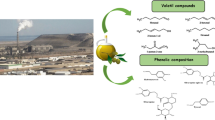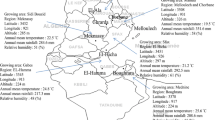Abstract
Volatile organic compounds of extra virgin olive oils obtained from the local Italian cultivar Grignano were measured by proton transfer reaction–mass spectrometry (PTR-MS). Oils were extracted by olives harvested at different ripening stages across veraison, performing each extraction step and the whole extraction process in nitrogen atmosphere to observe the changes in the volatile profiles of the oils. Principal component analysis carried out on the full spectral signature of the PTR-MS measurements showed that the stage of ripening has a stronger effect on the global definition of volatile profiles than the use of nitrogen during oil extraction. The fingerprint-like chemical information provided by the spectra were used to construct a heat map, which allowed the dynamical representation of the multivariate nature of mass evolution during the ripening process. This provided the first evidence that some groups of volatile organic compounds displayed a time course of regulation with coordinated increasing or decreasing trends in association with specific stages of fruit ripening.

Influence of olive fruit ripening and oil extraction in nitrogen atmosphere on volatile organic compounds has been evaluated by means of PTR-MS and multivariate data analysis.




Similar content being viewed by others
References
Carluccio MA, Massaro M, Scoditti E, De Caterina R (2007) Vasculoprotective potential of olive oil components. Mol Nutr Food Res 51:1225–1234
Fitó M, de la Torre R, Covas M-I (2007) Olive oil and oxidative stress. Mol Nutr Food Res 51:1215–1224
Grigg D (2001) Olive oil, the Mediterranean and the world. GeoJournal 53:163–172
Morales MT, Alonso MV, Rios JJ, Aparicio R (1995) Virgin olive oil aroma: relationship between volatile compounds and sensory attributes by chemometrics. J Agric Food Chem 43:2925–2931
Kalua CM, Allen MS, Bedgood DR Jr, Bishop AG, Prenzler PD, Robards K (2007) Olive oil volatile compounds, flavour development and quality: a critical review. Food Chem 100:273–286
Servili M, Selvaggini R, Taticchi A, Esposto S, Montedoro GF (2003) Air exposure time of olive pastes during the extraction process and phenolic and volatile composition of virgin olive oil. J Am Oil Chem Soc 80:685–695
Migliorini M, Mugelli M, Cherubini C, Viti P, Zanoni B (2006) Influence of O2 on the quality of virgin olive oil during malaxation. J Sci Food Agric 86:2140–2146
Angerosa F, Servili M, Selvaggini R, Taticchi A, Esposto S, Montedoro GF (2004) Volatile compounds in virgin olive oil: occurrence and their relationship with quality. J Chromatogr A 1054:17–31
Sánchez-Ortiz A, Romero C, Pérez AG, Sanz C (2008) Oxygen concentration affects volatile compound biosynthesis during virgin olive oil production. J Agric Food Chem 56:4681–4685
Servili M, Selvaggini R, Taticchi A, Esposto S, Montedoro GF (2003) Volatile compounds and phenolic composition of virgin olive oil: optimization of temperature and time of exposure of olive pastes to air contact during the mechanical extraction process. J Agric Food Chem 51:7980–7988
Kalua CM, Bedgood DR Jr, Bishop AG, Prenzler PD (2006) Changes in volatile and phenolic compounds with malaxation time and temperature during virgin olive oil production. J Agric Food Chem 54:7641–7651
Servili M, Taticchi A, Esposto S, Urbani S, Selvaggini R, Montedoro GF (2008) Influence of the decrease in oxygen during malaxation of olive pastes on the composition of volatiles and phenolic compounds in virgin olive oil. J Agric Food Chem 56:10048–10055
Aparicio R, Morales MT (1998) Characterization of olive ripeness by green aroma compounds of virgin olive oil. J Agric Food Chem 46:1116–1122
Morales MT, Aparicio R, Calvente JJ (1996) Influence of olive ripeness on the concentration of green aroma compounds in virgin olive oil. Flavour Frag J 11:171–178
Kalua CM, Allen MS, Bedgood DR, Bishop AG, Prenzler PD (2005) Discrimination of olive oils and fruits into cultivars and maturity stages based on phenolic and volatile compounds. J Agric Food Chem 53:8054–8062
Vichi S, Lazzez A, Kamoun NG, Lòpez-Tamames E, Buxaderas S (2010) Evolution of sesquiterpene hydrocarbons in virgin olive oil during fruit ripening. J Agric Food Chem 58:6972–6976
Angerosa F, Basti C, Vito R (1999) Virgin olive oil volatile compounds from lipoxigenase pathway and characterization of some Italian cultivars. J Agric Food Chem 47:836–839
Eisen MB, Spellman PT, Brown PO, Botstein D (1998) Cluster analysis and display of genome-wide expression patterns. Proc Natl Acad Sci USA 95:14863–14868
Tura D, Failla O, Bassi D, Pedò S, Serraiocco A (2008) Cultivar influence on virgin olive (Olea europaea L.) oil flavor based on aromatic compounds and sensorial profile. Sci Hortic 118:139–148
Peretti A (2007) Olio dop: dal Garda al Grappa la carica delle eccellenze. Origine 6:46–49 (in Italian)
Lindinger W, Hansel A, Jordan A (1998) On-line monitoring of volatile organic compounds at pptv levels by means of proton-transfer-reaction mass spectrometry (PTR-MS). Medical applications, food control and environmental research. Int J Mass Spectrom Ion Processes 173:191–241
Hansel A, Jordan A, Holzinger R, Prazeller P, Vogel W, Lindinger W (1995) Proton transfer reaction mass spectrometry: online trace gas analysis at the ppb level. Int J Mass Spectrom Ion Proc 149(150):609–619
Lindinger W, Hansel H, Jordan A (1998) Proton-transfer-reaction mass spectrometry (PTR-MS): on-line monitoring of volatile organic compounds at pptv levels. Chem Soc Rev 27:347–354
Hewitt CN, Hayward S, Tani A (2003) The application of proton transfer reaction-mass spectrometry (PTR-MS) to the monitoring and analysis of volatile organic compounds in the atmosphere. J Environ Monit 5:1–7
Hansel A, Editors MTD (2004) Proton transfer reaction mass spectrometry. Int J Mass Spectrom 239(2–3):77–254
Aprea E, Biasioli F, Sani G, Cantini C, Märk TD, Gasperi F (2006) Proton transfer reaction-mass spectrometry (PTR-MS) headspace analysis for rapid detection of oxidative alteration of olive oil. J Agric Food Chem 54:7635–7640
Araghipour N, Colineau J, Koot A, Akkermans W, Rojas JMM, Beauchamp J, Wisthaler A, Märk TD, Downey G, Guillou C, Mannina L, van Ruth S (2008) Geographical origin classification of olive oils by PTR-MS. Food Chem 108:374–383
Blake RS, Monks PS, Ellis AM (2009) Proton-transfer reaction mass spectrometry. Chem Rev 109(3):861–896
Boschetti A, Biasioli F, van Opbergen M, Warneke C, Jordan A, Holzinger R, Prazeller P, Karl T, Hansel A, Lindinger W, Iannotta S (1999) PTR-MS real time monitoring of the emission of volatile organic compounds during postharvest aging of berryfruit. Postharv Biol Technol 17:143–151
Buhr K, van Ruth S, Delahunty C (2002) Analysis of volatile flavour compounds by proton transfer reaction-mass spectrometry: fragmentation patterns and discrimination between isobaric and isomeric compounds. Int J Mass Spectrom 221:1–7
Hanson BA (2010) ChemoSpec: Exploratory Chemometrics for Spectroscopy. R package version 1.46. http://academic.depauw.edu/~hanson/ChemoSpec/ChemoSpec.html
Lucas A (2010) amap: Another Multidimensional Analysis Package. R package version 0.8-5. http://CRAN.R-project.org/package=amap
Warnes GR. Includes R source code and/or documentation contributed by (in alphabetical order): Bolker B, Bonebakker L, Gentleman R, Huber W, Liaw A, Lumley T, Maechler M, Magnusson A, Moeller S, Marc Schwartz M, Venables B (2010) gplots: various R programming tools for plotting data. R package version 2.11.0. http://CRAN.R-project.org/package=gplots
R Development Core Team (2009) R: a language and environment for statistical computing. R Foundation for Statistical Computing, Vienna, Austria. http://www.R-project.org
Jolliffe IT (1986) Principal component analysis. Springer, New York
Ollat N, Diakou-verdin P, Carde JP, Barrieu F, Gaudillere JP, Moing A (2002) Grape berry development: a review. J Int Sci Vigne Vin 36:109–131
Hubert M, Rousseeuw PJ, Vanden Branden K (2005) ROBCA: a new approach to robust principal component analysis. Technometrics 47:64–79
Hubert M, Engelen S (2004) Robust PCA and classification in biosciences. Bioinformatics 20:1728–1736
Davis BM, McEwan MJ (2007) Determination of olive oil oxidative status by selected ion flow tube mass spectrometry. J Agric Food Chem 55:3334–3338
Fall R, Karl T, Jordan A, Lindinger W (2001) Biogenic C5 VOCs: release from leaves after freeze–thaw wounding and occurrence in air at high mountain observatory. Atmos Environ 35:3905–3916
Romeo V, Ziino M, Giuffrida D, Condurso C, Verzera A (2007) Flavour profile of capers (Capparis spinosa L.) from the Eolian Archipelago by HS-SPME/GC-MS. Food Chem 101:1272–1278
Parliment TH, Kolor MG, Maing IY (1977) Identification of the major volatile components of cooked beets. J Food Sci 42:1592–1593
Morales MT, Luna G, Aparicio R (2005) Comparative study of virgin olive oil sensory defects. Food Chem 91:293–301
Defilippi BG, Kader AA, Dandekar AM (2005) Apple aroma: alcohol acyltransferase, a rate limiting step for ester biosynthesis, is regulated by ethylene. Plant Sci 168:1199–1210
Harriman RW, Tieman DM, Handa AK (1991) Molecular cloning of tomato pectin methylesterase gene and its expression in Rutgers, ripening inhibitor, nonripening, and never ripe tomato fruits. Plant Physiol 97:80–87
Pesis E (2005) The role of the anaerobic metabolites, acetaldehyde and ethanol, in fruit ripening, enhancement of fruit quality and fruit deterioration. Postharv Biol Technol 37:1–9
De Gouw J, Warneke C (2007) Measurements of volatile organic compounds in the Earth’s atmosphere using proton-transfer-reaction mass spectrometry. Mass Spectrom Rev 26:223–257
Biedermann M, Grob K, Morchio G (1995) On the origin of benzene, toluene, ethylbenzene and xylene in extra virgin olive oil. Z Lebensm Unters Forsch 200:266–272
Steeghs MML, Crespo E, Harren FJM (2007) Collision induced dissociation study of 10 monoterpenes for identification in trace gas measurements using the newly developed proton-transfer reaction ion trap mass spectrometer. Int J Mass Spectrom 263:204–212
Acknowledgements
This work was funded by “Regione Veneto”, Project “OLIDRUP” and by MURST ex-60%. A.V. was supported by a PhD grant of the Italian Ministry of Education, Research and University. The authors are greatly indebted with Mirko Sella (Azienda Agricola San Cassiano, Mezzane (VR), Italy) for kindly providing samples of cv Grignano olive fruits and olive oil.
Author information
Authors and Affiliations
Corresponding author
Electronic supplementary material
Below is the link to the electronic supplementary material.
ESM 1
Influence of olive fruit ripening and oil extraction in nitrogen atmosphere on volatile organic compounds has been evaluated by means of PTR-MS and multivariate data analysis. (PDF 238 KB)
Rights and permissions
About this article
Cite this article
Vezzaro, A., Boschetti, A., Dell’Anna, R. et al. Influence of olive (cv Grignano) fruit ripening and oil extraction under different nitrogen regimes on volatile organic compound emissions studied by PTR-MS technique. Anal Bioanal Chem 399, 2571–2582 (2011). https://doi.org/10.1007/s00216-010-4636-1
Received:
Revised:
Accepted:
Published:
Issue Date:
DOI: https://doi.org/10.1007/s00216-010-4636-1




